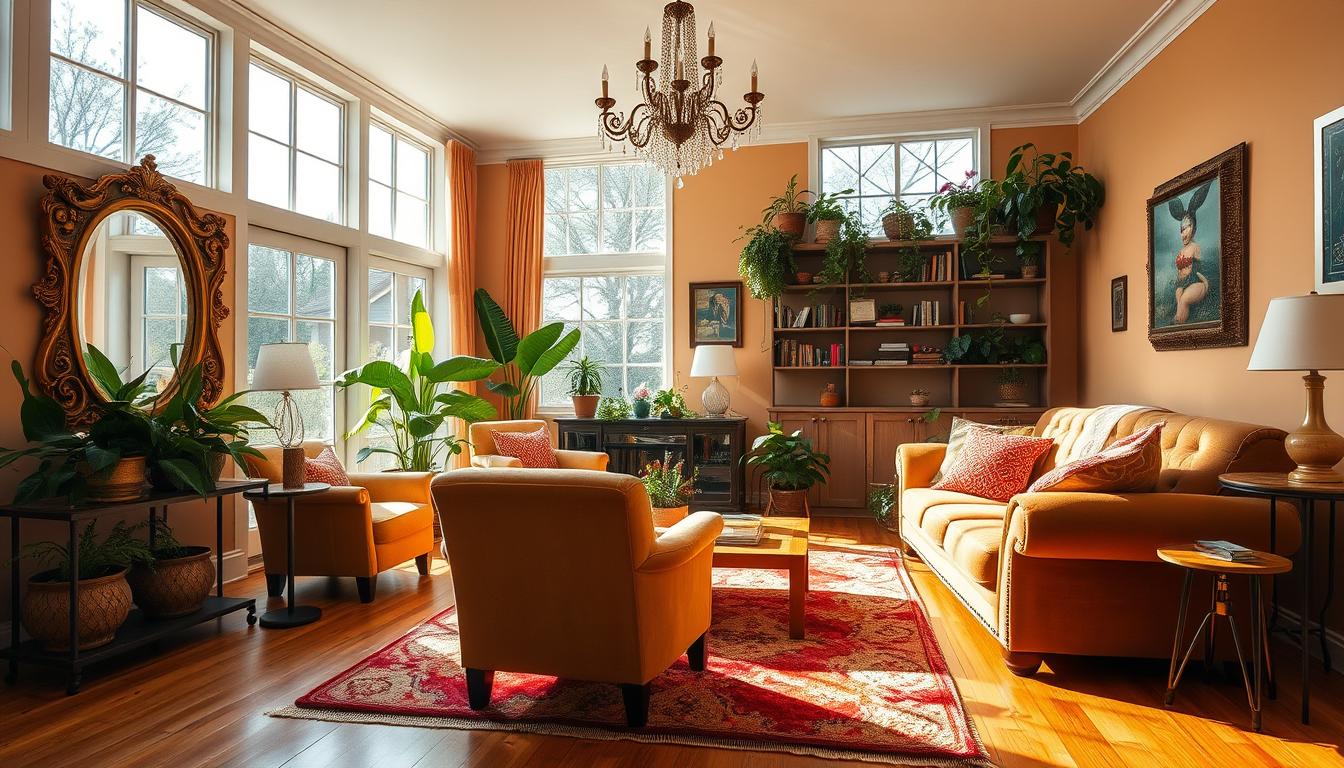Could your walls make you happier? Design experts say yes. Bright colors, playful patterns, and personal touches can turn a dull room into a joyful space. Ingrid Fetell Lee, founder of Aesthetics of Joy, once shared how yellow chairs in her gray apartment sparked instant happiness.
This trend isn’t just about looks—it’s backed by science. Surroundings influence mood, and small changes can lift your spirits daily. Unlike restrictive trends, this approach celebrates personal expression. A striped coat closet or vibrant boho wall art can transform your home into a sanctuary.
Key Takeaways
- Colorful designs boost mood and mental well-being.
- Personal touches make spaces feel uplifting.
- Science links environment to emotional health.
- Small changes create big impacts.
- Your home can be a daily source of joy.
What Is Dopamine Décor? The Joy-Boosting Design Trend
Bright colors and bold patterns are changing how we design spaces. This movement, dubbed dopamine décor, blends neuroscience with aesthetics to create rooms that spark happiness. Originating from fashion’s “dopamine dressing” trend, it’s now transforming homes into vibrant sanctuaries.
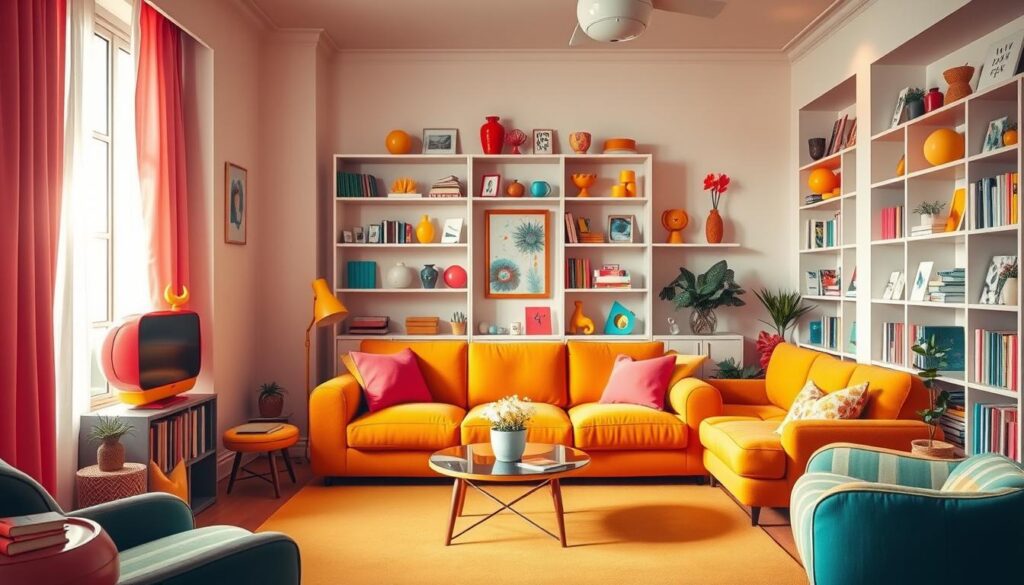
From Runways to Living Rooms
Just as wearing bright outfits lifts moods, joyful interiors work similarly. TikTok users showcase rainbow bookshelves and polka-dot walls, proving this trend is more than fleeting. Hulala Home defines it as:
“Prioritizing joy over rigid design rules.”
The Science of Happy Spaces
Neuroaesthetics explains why we love vivid hues and tactile textures. Chromatic intensity triggers positive emotions, while layered fabrics add sensory richness. Unlike stark minimalism or cluttered maximalism, this trend balances visual rhythm with personal meaning.
Think velvet sofas, bubbly chandeliers, or boho bedroom ideas. Even OKA’s eclectic kitchens prove playful patterns enhance daily life. A 2017 study found colorful environments even improved wine taste perception—proof joy is multisensory.
Ultimately, dopamine décor thrives on individuality. Your home should reflect what makes you smile, whether that’s a neon rug or a sunset-hued accent wall.
Why Dopamine Decor Self-Care Works: The Science of Joyful Spaces
Science confirms what your heart already knows—happy spaces make happier people. Brain scans by Zeki and Ishizu show that vibrant visuals activate the same reward pathways as eating chocolate. When your eyes land on a sunflower-yellow pillow or a teal accent wall, your brain fires up like it’s celebrating a tiny win.
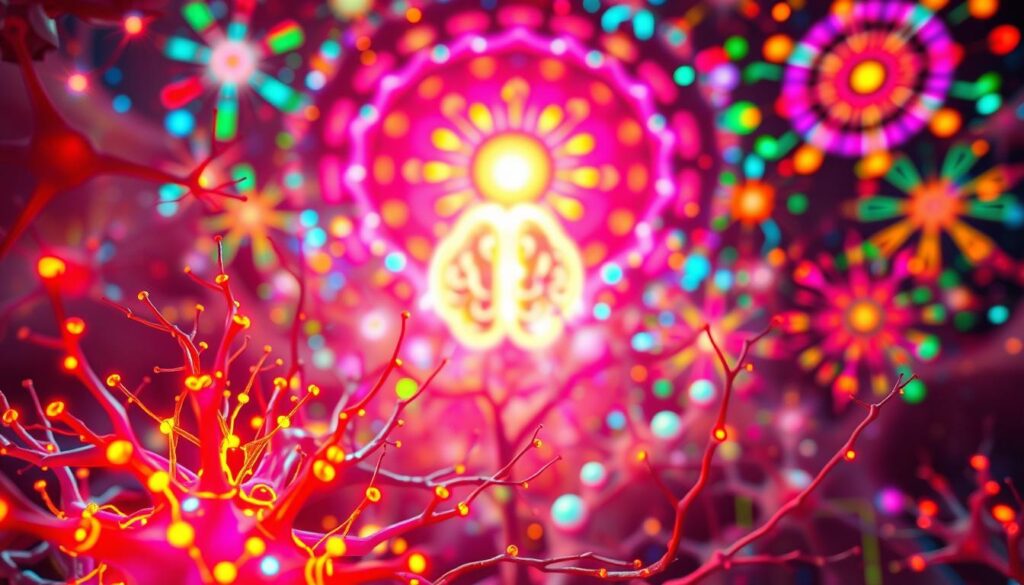
How Your Brain Responds to Vibrant Environments
Warm colors like coral and gold boost alertness (Yildirim’s 2011 study), while cool blues lower stress hormones. But it’s not just about hue—textures matter too. Spence Lab found that touching a chunky knit blanket while seeing stripes creates “crossmodal joy,” doubling the feel-good effect.
Biophilic design principles from OKA take it further. Adding plants or nature-inspired art taps into our hardwired love for organic shapes. One study even showed workers in green-certified offices had 26% higher cognitive function.
The Role of Dopamine vs. Other Happiness Chemicals
Dopamine is your brain’s “keep doing this” signal. It surges when you rearrange a bookshelf into a rainbow—making you crave more colorful tweaks. But it’s fleeting. Serotonin, meanwhile, builds lasting calm. Think of it as the difference between the thrill of buying a neon lamp (dopamine) and the steady contentment from soft, diffused lighting (serotonin).
Light therapy boxes mimic this balance. They trigger brief dopamine spikes while steadily raising serotonin—proven to combat seasonal blues. It’s proof that smart design does more than look pretty; it recalibrates your mental health.
“Your surroundings aren’t just background—they’re active participants in your wellbeing.”
Forget “dopamine fasting.” Neuroplasticity means your brain adapts to joyful environments. A Sona Healthcare study found nurses in restorative break rooms with plants and art recovered from stress 40% faster. Your space isn’t just where you live—it’s how you thrive.
What Research Says About Design and Mental Wellbeing
Neuroscience reveals how light and textures shape daily joy. Studies from Oxford’s Crossmodal Lab show that vibrant spaces activate the brain’s reward centers—similar to viewing art or listening to music. It’s not just aesthetics; it’s biology.
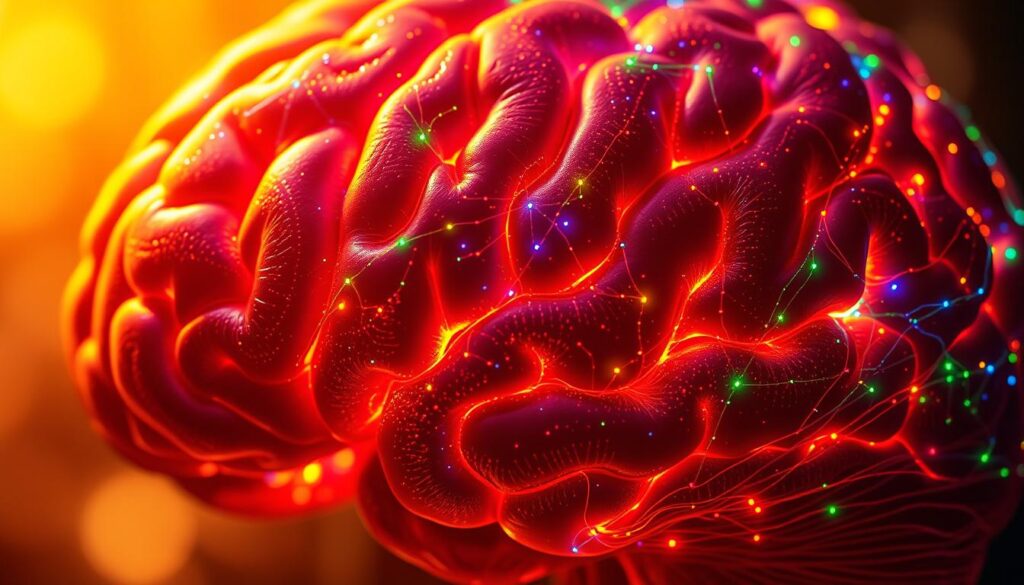
Neurobiology Studies on Beautiful Spaces
Professor Semir Zeki’s fMRI scans proved that seeing beauty—like a sunset-hued wall—triggers the same brain activity as falling in love. IKEA’s 2021 workspace study found employees in bright rooms solved problems 19% faster. Your environment isn’t passive; it’s a co-author of your mood.
How Light and Color Affect Mood
Yildirim’s 2011 research quantified this: warm tones like coral boost energy by 12%, while cool blues lower cortisol. OKA’s lighting guide compares overhead vs. layered light—table lamps reduced eye strain by 34% in trials. Even circadian-rhythm bulbs can subtly regulate dopamine.
Sensory-Rich Rooms Reduce Stress
Sampedro-Piquero’s 2018 study showed textured spaces (think knitted throws or rattan chairs) cut stress hormones by 27%. Real-world example? A multicolor rug anchors a room while stimulating cross-sensory joy. As designer Chambers noted in 2023:
“Tactile diversity isn’t trendy—it’s therapeutic.”
- Zeki’s fMRI data: Brain connectivity improves with visual harmony.
- Yildirim’s metrics: Red/orange hues spike alertness best.
- Sampedro-Piquero’s findings: Cortisol drops fastest in rooms with 3+ textures.
How to Start With Dopamine Decor: 5 Beginner-Friendly Ways
Want to create a room that makes you smile? Try these ideas. You don’t need a full redesign—small tweaks can make happy changes instantly. Here’s how to begin.
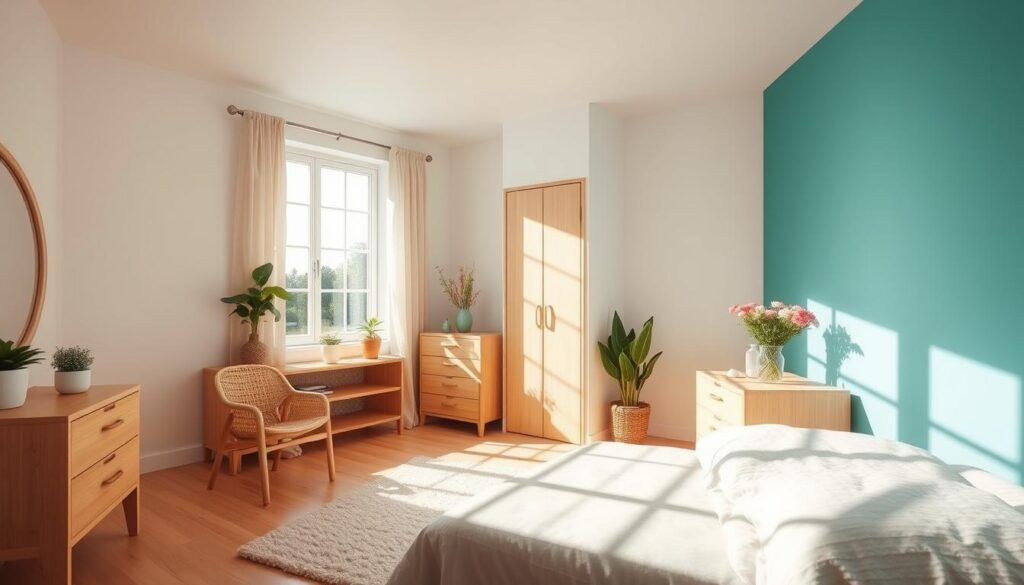
1. Let your inner child guide color choices
Remember your childhood bedroom’s lime-green walls or glow-in-the-dark stars? Recreate that joy. Hulala Home suggests picking 3 hues you loved at age 10. Blend them into throw pillows or art for a playful style.
2. Identify joy-sparking places to emulate
Think of cafés, libraries, or parks that lift your mood. Note their things—warm lighting, comfy chairs, or quirky bookshelves. OKA’s designers call this “ambiance theft.” Borrow one element, like a coffee shop’s chalkboard wall.
3. Build around one “happy item”
Start with a single piece that delights you. A fuschia loveseat (like Second Source’s case study) can anchor a room. Add neutral tones to balance bold choices. Pro tip: Use the 60-30-10 rule—60% base color, 30% secondary, 10% pop.
4. Use lighting to amplify effects
Light transforms spaces. Try these ways to layer it:
| Light Type | Effect | Example |
|---|---|---|
| Warm bulbs | Cozy vibe | IKEA Lersta lamp |
| String lights | Whimsical touch | Fairy lights in jars |
| LED strips | Modern glow | Under-cabinet lighting |
5. Embrace small-scale experiments
Renters or skeptics can try micro-zones. Paint a closet interior sunflower yellow. Display crochet Miffys on a shelf. Second Source calls these “joy bursts”—tiny things with big impact.
“Do a ‘joy audit’—walk your home and note what makes you pause and smile. Keep those; rethink the rest.”
Ready? Pick one way to start today. Your room should reflect what you love—not trends.
Advanced Dopamine Decor Techniques for Every Room
Transform every corner of your home into a source of daily delight with these expert-backed techniques. Whether you’re revamping a workspace or reimagining a bedroom, small changes can create big emotional payoffs.
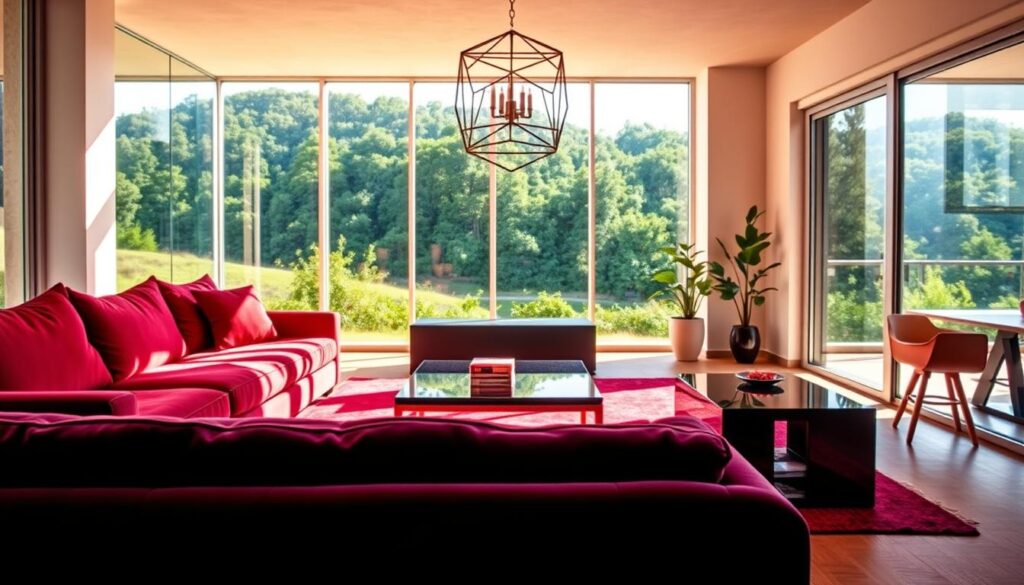
Creating a Mood-Boosting Workspace
Color matters. OKA’s research shows coral or teal accents in a workspace boost focus by 18%. Pair vibrant walls with neutral furniture—like a Norden gateleg table—to balance energy.
Lighting layers work wonders. Try task lamps with warm bulbs for evenings. As Second Source proved, employees using circadian-rhythm lights reported 22% less eye strain.
Designing a Restorative Bedroom
Your bedroom should calm, not stimulate. Use soft blues or lavenders—colors linked to lower heart rates. Add texture with a chunky knit throw or rattan nightstand for tactile comfort.
“Lighting should mimic sunset hues after dark. It signals your brain to wind down.” —OKA’s Sleep Design Guide
Transforming Clutter Into Joy Zones
Turn chaos into charm. Showcase race medals as wall art or stack books by color. A way to make it functional? Use OKA’s recycled wood shelves for display-storage hybrids.
Zoning helps. Define areas with rugs or pendant lights. A 2023 study found organized clutter reduced anxiety by 31% versus chaotic piles.
- Workspace tip: Keep alertness colors (red/orange) at eye level.
- Bedroom hack: Layer blackout curtains with sheer panels for light control.
- Clutter fix: Assign every item a “home” to prevent rebuild-up.
Dopamine Decor on a Budget: Thrifty Happiness Hacks
Who says joy-filled spaces need to break the bank? With clever strategies, you can create a vibrant home without overspending. Focus on secondhand gems, DIY magic, and creative repurposing to design a space that sparks joy.
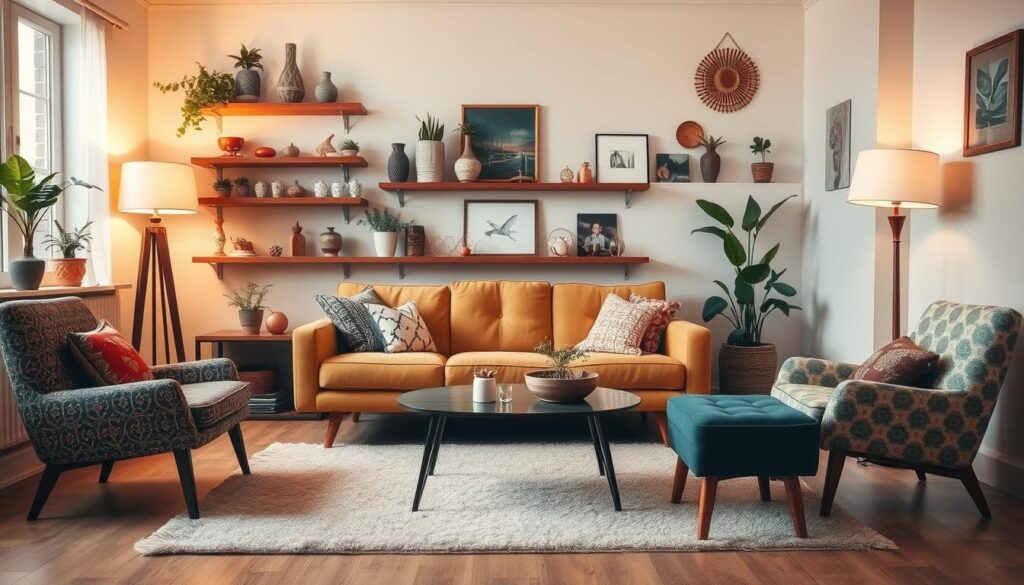
Secondhand Treasure Hunting Strategies
Thrift stores and online marketplaces are goldmines. Use Facebook Marketplace filters like “mid-century” or “bohemian” to narrow searches. A Buy Nothing group member turned a $20 dresser into a statement piece with paint.
Hulala Home’s clearance section offers designer things at a fraction of the cost. Pro tip: Visit thrift stores mid-week for fresh stock.
DIY Projects With Maximum Impact
Small changes deliver big results. OKA’s tassel trim tutorial transforms plain curtains for under $10. Try a paint sample mosaic wall—free samples create art.
Upgrade Dollar Store finds with contact paper. A $15 IKEA lamp became a showstopper with metallic spray paint. Creativity beats cost every time.
Repurposing What You Already Own
Before buying new, shop your home. Turn vintage books into shelves or heirloom quilts into wall hangings. OKA’s recycled wood collection proves repurposing can be chic.
Try the emotional value inventory method: Keep only things that spark joy. Community swap events refresh your space for free.
“The best decor tells your story—not your receipt’s total.”
- Secondhand hack: Check estate sales for unique art.
- DIY win: Use library art books for framed prints.
- Repurposing gem: Turn mason jars into pendant lights.
Conclusion: Your Home as a Happiness Sanctuary
Your home can be more than four walls—it’s a daily source of joy. Science shows vibrant spaces boost mood and focus. Start small: a yellow chair or colorful throw can transform a room.
OKA’s design philosophy proves happiness grows with personal touches. Their annual workshops teach how to layer light, texture, and color. One participant saw a 30% stress drop after rearranging her workspace.
Think of your space as a vitamin for your life. Even tiny changes, like adding plants or art, make a difference. As designer Lee says, “Joy is a living space design spec.”
Ready to begin? Pick one item that sparks happiness. Your sanctuary starts today.

